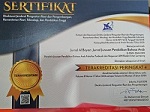The Effectiveness of Fun Learning Approach in Arabic Learning
Abstract
Keywords
Full Text:
PDFReferences
Al-Bulushi, Ali H., and Ali S. Al-Issa. “Playing with the Language: Investigating the Role of Communicative Games in an Arab Language Teaching System.” International Journal of Instruction 10, no. 2 (2017): 179–98. https://doi.org/10.12973/iji.2017.10212a.
Al-Jarf, Reima S., and Nailya G. Mingazova. “Evaluation of Arabic Language Teaching Textbooks Used in Russia in the Light of the CEFR Criteria.” In VI International Forum on Teacher Education, 1:101–29, 2020. https://doi.org/10.3897/ap.2.e0101.
Al-Khresheh, Mohammad H., Ahmad Khaerurrozikin, and Abdul Hafidz Zaid. “The Efficiency of Using Pictures in Teaching Speaking Skills of Non-Native Arabic Beginner Students.” Universal Journal of Educational Research 8, no. 3 (2020): 872–78. https://doi.org/10.13189/ujer.2020.080318.
AlNajdi, Sameer M. “Design a Blended Learning Environment to Teach Arabic Alphabet for Non-Arabic Speaker Children Based on ASSURE Model.” International Journal of Information and Education Technology 8, no. 2 (2018): 128–32. https://doi.org/10.18178/ijiet.2018.8.2.1021.
Arifin, Zainal. “Pengembangan Model Pembelajaran Bahasa Arab Berbasis Teori Multiple Intelligence” 1, no. 1 (2015).
Arwani, Agus. “The Role of The Arabic Language in Islamic Economy.” Alsinatuna 3, no. 1 (2013): 97–112.
Boudelaa, Sami, and William D. Marslen-Wilson. “Morphological Structure in the Arabic Mental Lexicon: Parallels between Standard and Dialectal Arabic.” Language and Cognitive Processes 28, no. 10 (December 2013): 1453–73. https://doi.org/10.1080/01690965.2012.719629.
Cahaya, Meta. “Penerapan Model Pembelajaran Inkuiri Untuk Meningkatkan Motivasi Belajar PPKn Siswa Di Kelas VII C SMP Negeri 7 Muaro Jambi,” July 23, 2020.
Chamout, Rima. “Improving Motivation in Arabic Language Arts Classroom Through Technology Integration.” Walden University, 2020.
Christiner, Markus, and Susanne Maria Reiterer. “Early Influence of Musical Abilities and Working Memory on Speech Imitation Abilities: Study with Pre-School Children.” Brain Sciences 8, no. 9 (2018). https://doi.org/10.3390/brainsci8090169.
Darmansyah. Strategi Pembelajaran Menyenangkan Dengan Humor. Jakarta: Bumi Aksara, 2011.
Davis, G. “Songs in the Young Learner Classroom: A Critical Review of Evidence.” ELT Journal 71, no. 4 (2017). https://doi.org/10.1093/elt/ccw097.
Djamarah, Syaiful Bahri, and Aswan Zain. Strategi Belajar Mengajar. Jakarta: Rineka Cipta, 2010.
Džanić, Nihada Delibegović, and Alisa Pejić. “The Effect of Using Songs On Young Learners and Their Motivation for Learning English.” NETSOL: New Trends in Social and Liberal Sciences 1, no. 2 (2016): 40–54. https://doi.org/10.24819/netsol2016.8.
“Fun Learning Approach - Nurturing A Passion For Learning • Fun Academy.” Accessed September 21, 2020. https://funacademy.fi/fun-learning-approach/.
Haycraft, John. An Introduction to English Language Teaching. Singapore: Longman Group Ltd., 1994.
Hendrawati, Anik, and Lantip Diat Prasojo. “Pengaruh Kepemimpinan Transformasional Kepala Sekolah, Motivasi Kerja Guru, Dan Budaya Sekolah Terhadap Prestasi Belajar.” Jurnal Akuntabilitas Manajemen Pendidikan 3, no. 2 (October 26, 2015): 141–57. https://doi.org/10.21831/amp.v3i2.6331.
Kurniati, Erisa, Muhammad Zaim, Jufrizal, and Jufri. “The Effectiveness of Audio Media for English Learning Based on Scripted Song at the Fifth Grade of Elementary School.” İlköğretim Online 20, no. 1 (2021): 208–16. https://doi.org/10.17051/ilkonline.2021.01.023.
Kuswana, W. S. Taksonomi Kognitif Perkembangan Ragam Berpikir. Bandung: Rosda Karya, 2014.
Masrai, Ahmed, and James Milton. “Recognition Vocabulary Knowledge and Intelligence as Predictors of Academic Achievement in EFL Context.” TESOL International Journal 12, no. 1 (2017): 128–42.
Moshtahari, Yahia. “The Usage of Songs in Arabic as a Foreign Language Classes : Teachers ’ Perceptions and Practices,” 2018.
Pasiak, Taufiq. Brain Management for Self Improvement. Bandung: Mizan Pustaja, 2007.
Roffiq, Ainoer, Ikhwanul Qiram, and Gatot Rubiono. “Media Musik Dan Lagu Pada Proses Pembelajaran.” Jurnal Pendidikan Dasar Indonesia 2, no. 2 (2017): 35–40.
Santosa, Purbayu Budi. Analisis Statistik Dengan Microsoft Excel Dan SPSS. Yogyakarta: Penerbit Andi, 2005.
Sinaga, Syahrul Syah, Susanto Susanto, Victor Ganap, and Tjetjep Rehendi Rohidi. “Musical Activity in The Music Learning Process Through Children Songs in Primary School Level.” Harmonia: Journal of Arts Research and Education 18, no. 1 (2018): 45–51. https://doi.org/10.15294/harmonia.v18i1.12508.
Somjai, Satit, and Kittitouch Soontornwipast. “The Integration of Implicit and Explicit Vocabulary Instruction, Project-Based Learning, Multimedia, and Experiental Learning to Improve Thai EFL Senior High School Students’ Vocabulary Ability.” Arab World English Journal 6, no. Special (2020): 171–90. https://doi.org/https://dx.doi.org/10.24093/awej/call6.12.
Susilawati, Susilawati. “Penerapan Metoda Bernyanyi Dalam Memingkatkan Kecerdasan Berbahasa Pada Pendidikan Anak Usia Dini (Studi Deskriptif Tentang Penerapan Metoda Bernyanyi Di PAUD Al Azhar Syfa Budi Parahyangan).” EMPOWERMENT : Jurnal Ilmiah Program Studi Pendidikan Luar Sekolah. Vol. 3, September 30, 2014. https://doi.org/10.22460/EMPOWERMENT.V3I2P141-151.581.
Wekke, Ismail Suardi. “Arabic Teaching and Learning: A Model From Indonesian Muslim Minority.” Procedia-Social and Behavioral Sciences 191, 2015, 286–90.
DOI: http://dx.doi.org/10.24042/albayan.v13i2.8681
Refbacks
- There are currently no refbacks.
Copyright (c) 2021 Jurnal Al Bayan: Jurnal Jurusan Pendidikan Bahasa Arab
License URL: https://creativecommons.org/licenses/by-sa/4.0
Editorial Office:
Jurnal Al Bayan: Jurnal Jurusan Pendidikan Bahasa Arab, Arabic Education Study Program, Faculty of Education and Teachers Training, Unversitas Islam Negeri Raden Intan Lampung
Jl. Endro Suratmin 1 Sukarame, Bandar Lampung 35131-Indonesia
e-mail: jurnalalbayan@radenintan.ac.id
http://ejournal.radenintan.ac.id/index.php/albayan/index
Jurnal Al Bayan: Jurnal Jurusan Pendidikan Bahasa Arab is licensed under a Creative Commons Attribution-ShareAlike 4.0 International License. p-ISSN 2086-9282 | e-ISSN 2549-1229









